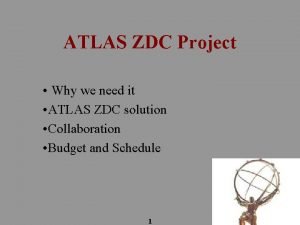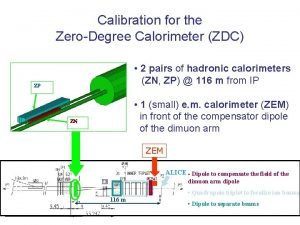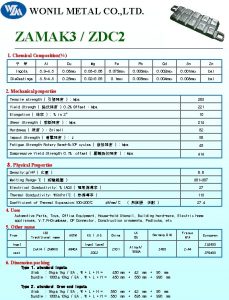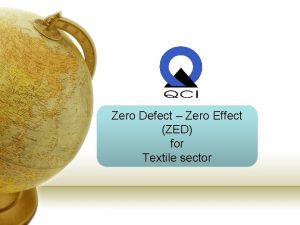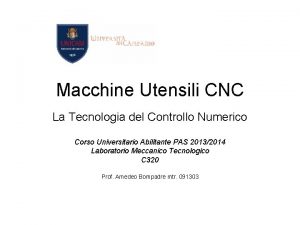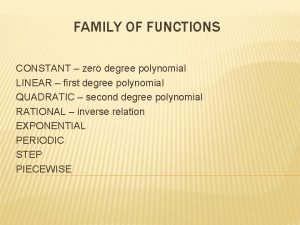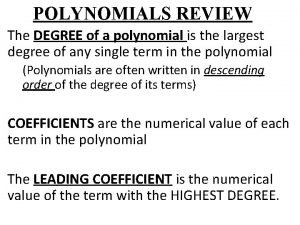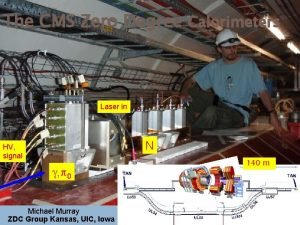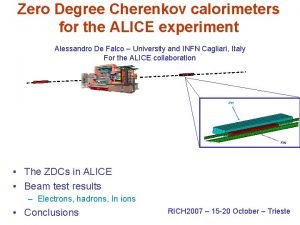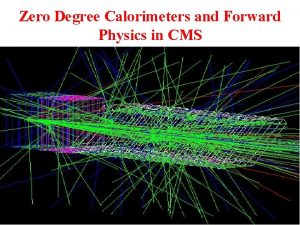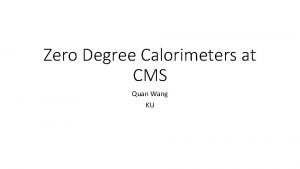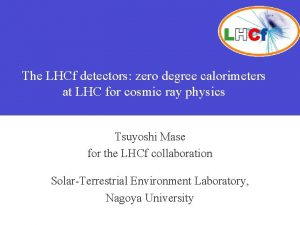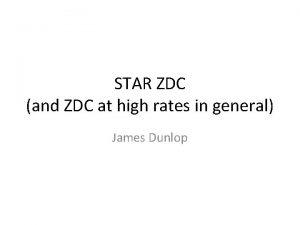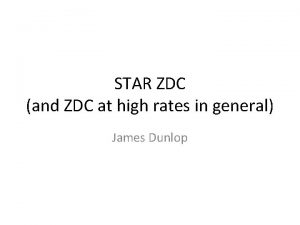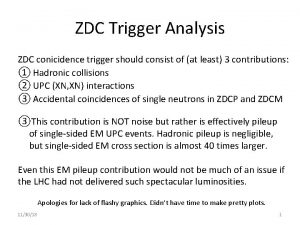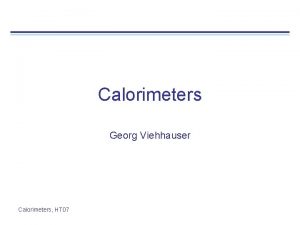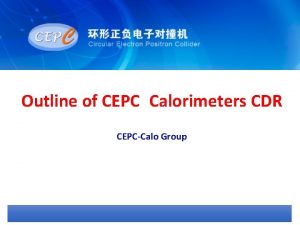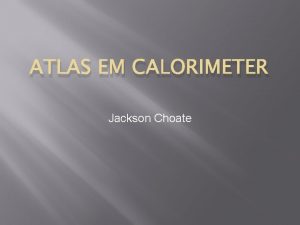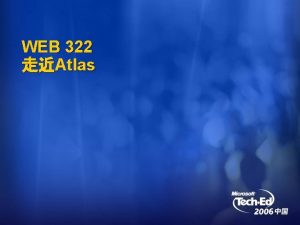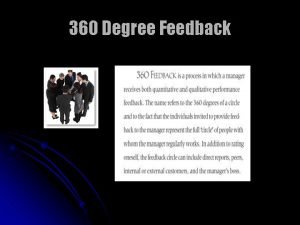Zero Degree Calorimeters for ATLAS ZDC Concept ZDC








































- Slides: 40

Zero Degree Calorimeters for ATLAS ZDC Concept ZDC Physics ZDC design ATLAS TDAQ integration ZDC performance (simulation, rad damage, testbeam) Planning/Installation Sebastian White, Brookhaven Lab LHCC – January 2007

ZDC in ATLAS A Zero Degree Calorimeter (ZDC) is a calorimeter that resides at the junction where the two beam pipes of the LHC become one – at 0° from the pp collisions. It is housed in the shielding unit that protects the S. C magnets from radiation, and measures neutral particle production at 0°. It can play many roles.

ZDC scenarios and cabling

Event characterization using forward detectors >>Direction and magnitude of impact parameter, b Reaction plane zz Magnitude from complementary parameters Nparticipant=2*A-Nspectator y x Spectator neutrons • measure centrality, • Min_min_bias trigger Beam-Beam Counter Mult/1000

Probing small x structure in the Nucleus with g. N->jets, in Ultraperipheral Collisions(UPC) x 1 x 2 di-jet photoproduction-> parton distributions, x 2 by g with momentum fraction, x 1 4 pt 2/s=x 1*x 2 <y>~ -1/2*ln(x 1/x 2) Signature: rapidity gap in g direction(FCAL veto) ATLAS coverage to |h|<5 units. Pt ~2 Gev “rapidity gap” threshold Analogous upc interactions and gap structure diffractive Non-diffractive

Rates and Kinematics Event yields from a 1 month HI (Pb-Pb) run at nominal Luminosity (4 1026 cm-2 s-1). Counts per bin of dpt=2 Ge. V dx 2/x 2=+/- 0. 25 (with M. Strikman and R. Vogt)

ZDC in pp( Phase II configuration) In pp, the ZDC can measure forward production cross sections for several types of particles at very high energies. This will be useful for adjusting parameters for simulations and models, and for cosmic ray physics where the energy in one proton’s rest frame is 1017 e. V – a very interesting energy for extended air showers. What happens when a high energy proton hits the upper atmosphere? The ZDC can find a pi 0 in the midst of several neutrons. (1 M Pythia events analyzed by a ZDC)

RHIC ZDC as an accelerator tool (in pp) • Van der. Meer scan (ZDC coincidence rate vs. relative beam position) • ZDC (lower curve) bkg free over 4 orders of magnitude • ZDC also measures beam displacement (red points) • Useful for crossing angle commissioning

ZDC scenarios and cabling

Aperture limitations from upstream components of the machine

EMCal Module design (1 module only) Light collected from Strips of 1. 5 mm quartz Transverse to beam (main energy and timing) And 1 mm quartz rods Projective to beam Latter measure coordinate Of showers.

Strip detail and air Lightguide 648 1. 5 mm diameter rods Provides main energy and Timing measurement

Hadronic module with Coordinate readout ( 1 module per arm) Rods are grouped into 4 per readout pixel

Inserting coordinate readout fibers

Summary of ZDC module parameters

Block Diagram of ZDC Readout scheme

ZDC L 1 trigger • The ZDC trigger will be used primarily as a 2 -arm coincidence (each arm above a preset threshold) in Heavy ion runs • Trigger bits assigned in Central trigger Processor • CTP is designed to accept calibration triggers as well as trigger from small systems like the ZDC

ZDC time, space and energy resolution (Average over active area) ZDC response to neutrons Neutron space resolution Neutron energy resolution Neutron time resolution Photon energy resolution Photon space resolution

Background (PYTHIA / GEANT simulation) Sources of signal and Background Interaction Point Decays in Flight “Walls”

Background (PYTHIA / GEANT simulation) Sources of Signal and Background Interaction Point Decays in Flight “Walls”

Absorbed dose (rad/yr) in TAN at luminosity 1033 cm-2 sec-1 ~1 krad MAPMT PMT PMT 180 TAN slot 150 ~1 Mrad ~100 Mrad Beam 180 ~1. 8 Grad 290 ~100 krad 800 Ionization chamber ~10 krad ~100 Mrad ~10 Mrad 90 150 30 100 150 30 150 1000 150

We exposed quartz rods at the BNL linac Isotope Producer facility At 5 Grad absorbed dose, light loss corresponds to a 30% deterioration in resolution of coordinate measurement

Test beam exposure in SPS North area parasitic with RP (Oct. ‘ 06) Single module exposed to 230 Ge. V proton beam Spectra with 0, 10 and 20 cm steel blocks inserted in the beam Comparison to simulation (note same energy scale used in all Simulations)

Beam tuned to enrich positron component. Peak used to confirm light yield and agreement With simulations

Summary of cables to USA 15 Already installed Risetime of fast signals tr= 5 nsec Attenuation 50%

What we are planning • Install full (8 module) ZDC phased with the LHCf run plan • Integrate ZDC into ATLAS DAQ and provide a level 1 trigger • Will remove ZDC for highest Luminosity pp runs • Provide a critical role in Heavy Ion program • Important measurements of forward particle production in pp collisions over full acceptance permitted by TAN constraints • Funding from US Nuclear Physics program

Schedule • 1 st module completed and tested in beam-no design changes planned • Construction of mechanical modules can begin 2/07 expect completion in 6/07 • Remaining cables installed this spring • Main schedule uncertainty is window for installation of cables and modules • Operation possible at end of ‘ 07 in conjunction with LCHf detector

Extra slides

Tested correlation between coordinate measurement and Position of 2 mm high beam scintillation counters

Simulation of kinematic acceptance

Energy resolution for Photons and neutrons (GEANT simulation) Coordinate resolution for photons and neutrons

L 1 Calo boards • We require 5 Pre. Processor modules • Current production is for 180 modules of which 120 modules needed for L 1 calo system (Karl. Heinz Meier, Heidelberg) • Project would be charged for cost of materials (~10 k euro/module) • 1 ROD sufficient

Phasing with LHCf run Phase II


ZDC Project file (p. 1) including Phase II eqpt and labor costs

Concept for remote module replacement Left/Right 965 Up/Down Cables 190 94 520 Left/Right 180 100 180 760 980 150

Background MARS 15: Radiation in TAN, LHCf & ZDC – N. Mokhov TAN Integration – CERN, Mar. 10, 2006

ZDC cable detail

X-Y rod holder

Assembling module: installing X-Y rods Bare module Rod is put in module and measured Rod is removed, cut to size and replaced All rods installed
 Zdc whitepaper
Zdc whitepaper Zdc 2
Zdc 2 Zdc v2
Zdc v2 Zero defect zero effect
Zero defect zero effect Cos'è lo zero pezzo
Cos'è lo zero pezzo Zero polynomial
Zero polynomial Polynomial review
Polynomial review Borra hål för knoppar
Borra hål för knoppar Tack för att ni har lyssnat
Tack för att ni har lyssnat Smärtskolan kunskap för livet
Smärtskolan kunskap för livet Jiddisch
Jiddisch Typiska novell drag
Typiska novell drag Fimbrietratt
Fimbrietratt Frgar
Frgar För och nackdelar med firo
För och nackdelar med firo Ellika andolf
Ellika andolf Vilka tal pekar pilarna på
Vilka tal pekar pilarna på Toppslätskivling dos
Toppslätskivling dos Redogör för vad psykologi är
Redogör för vad psykologi är Bra mat för unga idrottare
Bra mat för unga idrottare Gumman cirkel
Gumman cirkel Bris för vuxna
Bris för vuxna En lathund för arbete med kontinuitetshantering
En lathund för arbete med kontinuitetshantering Etik och ledarskap etisk kod för chefer
Etik och ledarskap etisk kod för chefer Offentlig förvaltning
Offentlig förvaltning Datorkunskap för nybörjare
Datorkunskap för nybörjare Antikt plagg
Antikt plagg Rita perspektiv
Rita perspektiv Ministerstyre för och nackdelar
Ministerstyre för och nackdelar Plats för toran ark
Plats för toran ark Nationell inriktning för artificiell intelligens
Nationell inriktning för artificiell intelligens Claes martinsson
Claes martinsson Sju principer för tillitsbaserad styrning
Sju principer för tillitsbaserad styrning Nyckelkompetenser för livslångt lärande
Nyckelkompetenser för livslångt lärande Ro i rom pax
Ro i rom pax Bra rim texter
Bra rim texter Mästar lärling modellen
Mästar lärling modellen Matematisk modellering eksempel
Matematisk modellering eksempel Orubbliga rättigheter
Orubbliga rättigheter Kassaregister ideell förening
Kassaregister ideell förening Verktyg för automatisering av utbetalningar
Verktyg för automatisering av utbetalningar
